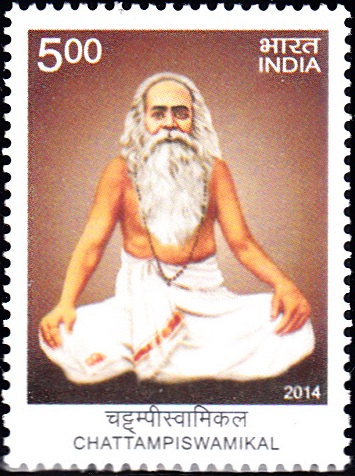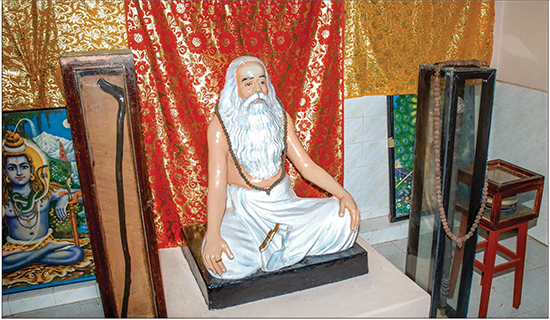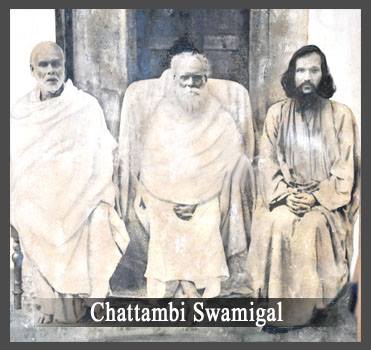PARAMA BHATTARA SREE VIDYADHIRAJA CHATTAMPI SWAMIKAL (1853 – 1924), the great peripatetic scholar, lived in Kerala, the southernmost state of India. His religious quest and discovery, his austere simplicity and great self-denial, his humble sharing with others the light with which he himself was illumined, his loving tenderness for all living creatures are all inspiring and instructive for all time.
Here (in Kerala) I met a remarkable saint.
Swami Vivekananda
CHATTAMPI SWAMIKAL, as he is popularly known, was not an organiser or a propagandist. He strictly adhered to the characteristic virtues of an ideal sage practising Ahimsa (Non-violence), Sathya (Truthfulness), Asteya (Non-stealing), Brahmacharya (Celibacy) and Aparigraha (Non-Acquisition) as an exemplar of this mode of life. His influence widened the vision of many and imparted self-confidence to innumerable people, leaving a mark in the religious attitude of a large section of people.
Material deprivation failed to dampen his spirit and penury could not hamper Swamikal from becoming a mastermind by his own latent genius and prodigious intellectual industry. In spite of the narrow and restrictive conventions that existed in his times, he mastered many branches of art and learning. His painstaking study of Tamil and Sanskrit from competent scholars outside Kerala gave him remarkable command over Vedanta. His gifted mind found no rest till his proficiency in Yoga measured up to ostensible results. He travelled miles and miles on foot in search of knowledge, and when he acquired it, he wandered again as the inspirer of people. Chattampi Swamikal strove to educate people in egalitarian doctrines and to liberalize traditional religious ritual practices by his writings and example.
He was the precursor of many liberal trends, but he was not an avowed social reformer. While exposing the sacerdotal pretensions of the high priests of society and demolishing the arrogant claims of the top rungs in the ladder of caste hierarchy, in his polemical writings, he never precipitated inter-communal envy or bickerings. He was urged by a sense of historical justice rather than personal pride. He always extended his hands to those below him to raise them up. His vision of unity (Samadarsana) was the outcome of his vedantic conviction that Atman is Brahman, that each man is potentially divine and that all existence is one: the essence of Vedantic Wisdom.
Saints are the common property of humanity. The Spheres of their activities are, by and large, confined to particular regions. It is for us to make available knowledge of their life and ideas prevalent in one region to others also, across the barrier of language and time. By doing so we aid the emotional integration of mankind.

A GLIMPSE OF SREE CHATTAMPI SWAMIKAL’S LIFE
Adi Sankara united the warring Hindu sects through his Advaita philosophy, affirming faith in the Vedic dictum – Ekam Sat (There is only one God). But after him the caste system and the resultant untouchability wrought havoc among the Hindus. Many of them were compelled to convert themselves into Christianity and Islam to escape the humiliation that the caste system meted out to them. The onslaught of these religions shook the fundamental unity of Hinduism. It was at such a time that Paramabhattara Sree Chattampi Swamikal incarnated as the saviour of Hinduism.
Childhood and Education
Swamikal was born in 1853 at Kollur, Thiruvananthapuram. His parents were Vasudeva Sharma and Nangamma Pillai. Though christened Ayyappan, he was known by his pet name Kunjan. Among his ancestors were reputed scholars, reversed saints and respected siddhas.
Kunjan was a child prodigy. He didn’t get any formal primary education. He learnt Tamil and Sanskrit from the books he borrowed from school boys. He used to overhear the Sanskrit classes conducted for brahmin boys by a Sastrikal. Impressed by the high standard of Kunjan the teacher admitted him to his class and soon Kunjan attained remarkable proficiency in Sanskrit. Pettayil Raman Pillai Asan, a great scholar, made him the Chattampi (Monitor) of his school, and this appellation stuck to him and he is known by it. Kunjan had to discontinue his studies with Pettayil Asan. A starving mother had to be given victuals rather than knowledge for sustenance. He had to support his family. He worked as a casual labourer and carried headloads of bricks and mortar for the construction of the Secretariat building in Thiruvananthapuram. Later he became a licensed scribe in Kerala and Tamilnadu. He got the job of an Accountant in Government service. Finally, leaving this all, he joined an organisation where religious topics were discussed and music lessons were imparted. Swaminatha Desikar, a Tamil Lecturer, taught him Tamil Vedanta Sastra and Tamil Grammar. Subbajadapatikal, an eminent saintly scholar, took Kunjan to Tamilnadu and taught him everything he knew. After four year’s study there he returned to Kerala.
His Attainment of Sainthood
Even from his childhood Swamikal used to immerse himself in japa and meditation. He was a regular visitor to many temples. Once an aged Sannyasi, who appeared near an Ayyappa temple where Kunjan used to do odd jobs, initiated him into Bala Subramaniya Mantra and assured him that it would give him every thing he wished for. Kunjan attained divine powers by reciting the Mantra lakhs of times and was known as Shanmukhadasan at that time. Later he himself revealed that he had initiated his sannyasi disciples into this potential mantra and found it effective. While he was studying in the Asan’s school he was found often in a trance embracing the Sivalinga at a near by Siva temple. After his mother’s death he left home forever and travelled extensively in South India, met many sages and siddhas. He learnt different languages. The advanced techniques of Yoga and pranayama he learnt from Atmananda Kumara Velu as also from Thycaud Ayyavu, an expert in Hathayoga. He had already learnt the basic tenets of Christianity and Islam from Christian and Muslim scholars. He was blessed with self-realization through the Brahmatatwopadesa of a mysterious Avadhuta saint. Kunjan Pillai transformed himself into Vidhyadhiraja and he was acclaimed as the Supreme Rishi of Kerala. Then he was only 28 years old.

A Crusader for Social Reforms
Despite the fact that Sannyasins sacrifice everything for attaining Self-realization, many of them live among the people to fulfill their obligation to society. Swamikal travelled extensively in Kerala to eradicate the evil customs and practices rampant in society. His vast Vedantic knowledge helped him much in dispelling the ignorance prevalent among the people. He questioned the legitimacy of the supposed supremacy of the upper caste Hindus and strove to cure them of their superstitious beliefs and customs. He disliked casteism. He stayed and dined with untouchables inviting the wrath of his own orthodox community. Through his sannyasi disciples, household disciples and literary works, he put into practice what he preached. Swamikal is considered the foremost crusader who brought about incredible transformation in the religio-spiritual and socio-cultural atmosphere of Kerala. He was the guiding star to those who fought to bring about spiritual renaissance and social resurgence in this country.
His Meeting with Swami Vivekananda
In 1982 while Swamikal was staying in the house of a devotee at Ernakulam, he came across Swami Vivekananda who was on his Parivrajaka (wandering monk) tour at the time. They spoke in Sanskrit. Swami Vivekananda introduced the topic of Chinmudra and asked Swamikal to unfold its esoteric meaning and its role in achieving higher levels of consciousness. Swamikal quoting from an old commentary on the Brahadaranya Upanishad, still unpublished, explained that when the tips of the forefinger and index finger touch together a vibratory energy would be produced, and it would flow up to the Sahasrara Padma of the aspirant elevating him to a higher stage of consciousness. Swami Vivekananda was very much impressed by this exposition and wished to have spiritual discussion with swamikal the next day also. Swami Vivekananda had at last seen a Kerala Prathibha (genius).
A Master of All Arts
Chattampi Swamikal had commendable mastery over diverse fields of knowledge. He possessed extraordinary memory power. Veda, Grammar, Astrology, Ayurveda, Yoga, Tarka Sasthra, Tantra Vidya and Tamil and Sanskrit literature were a few areas of his interest. He was a singer and composer. While his favourite art was music, his favourite instrument was Ganjira. His skill in playing on any instrument with originality was widely known and acclaimed. He was interested in acting, particularly in Kathakali. He was equally good at painting. He was a wrestler par excellence. His poems and writings were the offsprings of necessity. His Yoga Siddhi had given him the power of prophecy.
His Way of Life
He lived a life of austere simplicity. A mundu (a garment worn around the waist in kerala) an iron ring, and old umbrella, a walking stick and a Ganjira were his only possessions. He had no home and no intimate friends. This world was his family. He flitted from place to place like a carefree singing bird. He would not eat food cooked in a kitchen which prepared non-vegetarian dishes. He disliked alcohol and condemned the vice of drinking. He shared his food with ants, cats and dogs. He slept on a simple cot or on the bare floor. He looked no different from a rustic. He had a lively sense of humour. He ignored all distinctions of caste. He was fond of children. He would organize impromptu programmes that would stimulate their intelligence and exercise their bodies. His indifference to wealth was well known. 80 acres of land registered in his name were promptly gifted away. He was considerate to all his associates. Swamikal followed Nivritimarga (sannyasa) so that he didn’t stay at any place for long or established any Asramam to spread his ideals.
On his Shashtiabdapurthi(60th birthday) in 1913, at a simple meeting presided over by Swami Dayananda, the title of Vidhadhiraja Theerthapada Paramabhattara was conferred on him by distinguished scholars. But Swamikal, in his usual humility, said that he preferred to be known by the old name Chattampi.
A Man of Miracles
The spiritual and mystical powers that Chattampi Swamikal had acquired were innumerable. But he was ever averse to showing off. If on rare occasions he was unavoidably compelled to display them, his intention was not to win credit or impress others. His brahmacharya and intense tapas had conferred upon him all the Yogasiddhies.
Swamikal possessed a commanding power over natural elements, animals and human beings alike. But he never misused these powers for selfish ends. He had the power to cure seemingly incurable diseases and make cobras and even tigers obey his behests.
The Feast for Dogs is considered the most popular miracle he performed. One day Swamikal accepted the initiation of a vain officer to dine at his house, on condition that he should be allowed to bring with him some of his disciples. When the feast was served on leaves a pack of stray dogs entered the hall, sat by the leaves and had their meals in an uncharacteristically disciplined way. They finished their meal, took the leaves outside and disappeared mysteriously. To the astonished host, Swamikal said, ‘These dogs were high officers in their last life. Corruption, oppression, plunder and other heinous crimes led to their being reborn as dogs. The wages of sin are sure to be paid in the next life if not in this’.

The Theerthapada Sampradaya(tradition)
To rejuvenate Hinduism, Chattampi Swamikal established the Theerthapada Sannyasi order uniting the Advaita Siddhanta of Adi Sankara with the Saiva Siddhanta followed by Dravidian saints like Appar, Thirujnanasambandar, Sunderamoorthy, Manikyavachakar et.al. The Theertha order is the first in the Dasanami sannyasa order established by Adi Sankara. The aim of this new order was to propagate the methods of Yogajnana in accordance with the culture of Kerala.
Sree Nilakantatheerthapada Swamikal and Sree Theerthapada Paramahamsa Swamikal were his two prominent disciples. Most of this disciples belonging to different strata of society were house-holders. All these disciples and devotees of Swamikal made significant contribution to social and spiritual regeneration of the people of Kerala.
A Perfect Jeevanmukta
A Jeevanmukta is the liberated individual who while still living in the physical body is not conditioned by the limitation of his gross constitution and believes the entire universe to be the manifesation of the Absolute or his highest self. Such great souls see and experience Brahma Tattwa in a Brahmin, a cow, an elephant, a dog and the one who eats a dog, all alike without any distinction. They enjoy the Bliss of Self at all times and roam about for the well being of humanity at large. When their Prarabdha Karmas are over, they cast off their bodies, and the Jeevan dissolves in the Absolute Brahman.
Sree Chattampi Swamikal was such a Jeevanmukta with Sarvatra Samadarsan. (Experiencing unity in all)
His Mahasamadhi
Swamikal didn’t settle down at any particular place. Towards the end of his life, he revisited places like Thiruvananthapuram as if bidding farewell to them. He settled down at Panmana, a village 18km north of Kollam, enjoying the services rendered by his disciple Sree Kumpalathu Sanku Pillai, a young and spirited freedom fighter. Hundreds of people used to visit him to have his darshan and seek his advice and blessings. He used to receive them all with warmth. Gradually all the infirmities of old age began to attack him. He used to remind his disciples that all the ills that the flesh is destined to endure have to be endured before the soul would secure its release. He prophesied the time of his final departure though many could not understand it. When the final moment came Swamikal sat himself in Padmasana and mediated on Brahman. In that pose, in a few seconds, Swamikal entered into Eternal Samadhi at 4 pm on 5 May 1924. His mortal body was laid to rest at the place he had already selected for it. At the Samadhi Peedom a Sivalinga was installed as he had instructed.
My teacher Sree Swami Thapovanam had a great reverence for Sree Chattampi Swamikal and it is in fact from Sri Gurudev that I heard so often of the spiritual and mystical glory of this rare sage of Kerala. Sree Chattampi Swamikal has been one of the constant altars at which I have surrendered and invoked endless streams of power and strength. His spiritual stature is unmatched by any of the greatest men I have so far met. What I am today capable of in serving the world I owe to this unique Sage… It seems that I had a secret initiation at the hands of the Swamikal. My homage at the altar of this Majesty of knowledge.
Swami Chinmayananda
His Message
Chattampi Swamikal belonged to that rare band of religious leaders and world benefactors who led a selfless life in the midst of common people with their mundane concerns. They set an example for others to follow. They raise the moral and spiritual standards of the society they live in.
Swamikal visualised a universal family of man without the barriers of caste or creed. With his abundant love and compassion for all created things, he started a new epoch in spiritual regeneration. Humble creatures like ants and dogs were his brothers or friends.
Swamikal considered Ahimsa as the highest duty. He detested the killing of animals and the eating of meat. He believed that the path of Ahimsa led to Salvation. He declared that Brahmins and non-Brahmins have equal right to learn the Veda. He himself studied the Vedas and other sastras, hitherto denied to non-Brahmins. He explained Vedanta in a lucid style that could be understood even by an illiterate. He pointed out that women have equal, if not even more, rights in society. Few people have laboured harder than Swamikal to enable the people to break the chains of hereditarily acquired or traditionally held customs and practices to regain, maintain and strengthen their self respect. His ideal of a new social structure involved all mankind united by the bond of love.














Discussion about this post